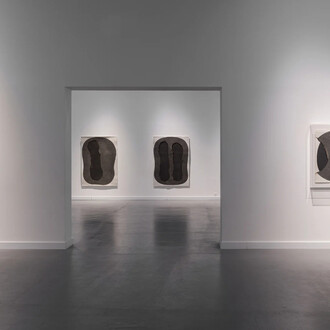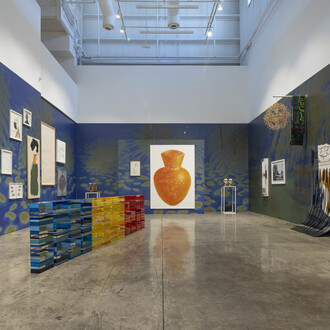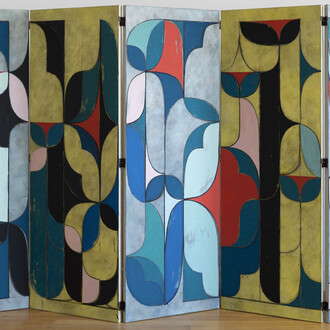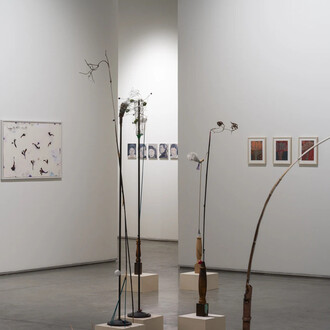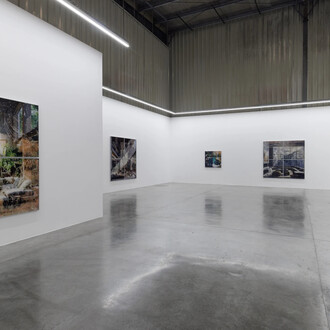Ayyam Gallery Dubai (11, Alserkal Avenue) is pleased to present Thresholds, the solo show of Sharjah-based painter Mouteea Murad. Organised by critic and curator Murtaza Vali, Thresholds highlights the artist’s latest body of work as he further experiments with the use of mathematics in geometric abstraction, an approach to non-objective art that he developed over the course of a decade.
In the three years since his last exhibition in the United Arab Emirates, Murad has placed a greater emphasis on space and dimension in his paintings, drawing on the formalism of Op art. He returns to Dubai with large-scale works that use the Fibonacci number sequence as a starting point for large-scale compositions. Murad’s recent canvases explore the growth patterns that result from the numerical series as he uses it to create a sense of movement and the illusion of expanding space. By doing so, he encourages the viewer to engage each work with a phenomenological sensibility.
Murad applies the Fibonacci series to grid-like patterns that partially conceal the interactions of polygons and lines, thus creating the illusion of depth. The artist’s grids are reminiscent of windows or screens that obscure a hidden realm. As the squares of the grids grow in size, Murad’s paintings appear to swell and contract in front of the viewer.
In the mural size work, Trial 125, Rainbow - Rain and Light and Love (2016), for example, the artist uses uniform bands that seem to decrease in width towards the centre of the composition. The painting is divided into seven distinct planes that are organised according to similar hues and contain intersecting lines. Here, colour relativity also plays a central role in creating vast space. Although composed of geometric arrangements, each plane can be read as a different colour field where light dances in sequence. The white bands that position these areas of colour reach the upper and lower edges of the painting, eventually fading into a white background, suggesting infinity. Murad’s composition stretches across the canvas yet his grid seems suspended, as though held in mid air by opposite poles. If the artist’s title describes the sensation of rain and light as seen in the interplays of colour and line that form the painting’s expanse, then perhaps the element of ‘love’ that he refers to is the gravitational force that keep these elements in place.
The opening of Thresholds will also serve as the launch of a new monograph on the artist that surveys the various periods of his work. Included in the publication are essays by Samia Halaby, Maymanah Farhat, and Murtaza Vali.
Mouteea Murad’s work sees a unification of spirituality and formalism, continuously drawing influence from the geometric forms and motifs of Islamic art. Murad began his career as a painter working on monochromatic, expressionist compositions that depict the anguish of modern man. In 2007, he adopted on a renewed outlook that redirected his painting style, exploring relativity, spatiality, and the visual dynamic of geometric forms.
The evolution of Murad’s work is reflected through the gradual stages of abstraction in his compositions as he builds on the breakthroughs of previous movements, experimenting with automatic brushwork, the illusionistic perspective of Op art, the symmetry of geometric abstraction, and the collapsing planes of Suprematism. In his most recent series, his interest in mathematics plays an integral role, with the Fibonacci numbers and sequence at its centre. His forms and lines are largely defined by algebraic functions and their geometric application within the work.
Murad lives and works in Sharjah, United Arab Emirates. He received a Bachelor of Art from the Faculty of Fine Arts, Damascus in 2001. Selected solo exhibitions for the artist include Ayyam Gallery Beirut (2011); Ayyam Gallery DIFC, Dubai (2011); and Ayyam Gallery Damascus (2010). His work can be found in private and public collections internationally, including the Jordan National Gallery of Fine Arts.





